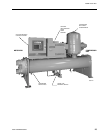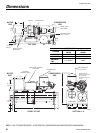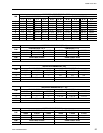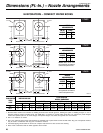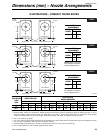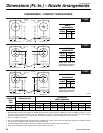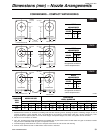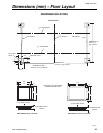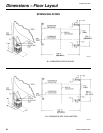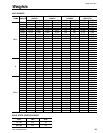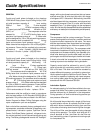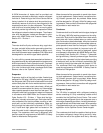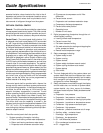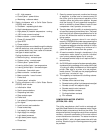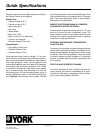
38
YORK INTERNATIONAL
FORM 160.81-EG1
Guide Specifications
operated isolation valves located at the inlet to the oil
separator and outlet of the condenser (isolation valves
optional). Additional valves shall be provided to facili-
tate removal of refrigerant charge from the system.
OPTIVIEW CONTROL CENTER
General – The chiller shall be controlled by a stand-alone
microprocessor based control center. The chiller control
panel shall provide control of chiller operation and moni-
toring of chiller sensors, actuators, relays and switches.
Control Panel – The control panel shall include a 10.4-
in. diagonal color liquid crystal display (LCD) surrounded
by "soft " keys which are redefined based on the screen
displayed at that time. This shall be mounted in the middle
of a keypad interface and installed in a locked enclosure.
The screen shall detail all operations and parameters,
using a graphical representation of the chiller and its ma-
jor components. Panel verbiage shall be available in other
languages as an option with English always available.
Data shall be displayed in either English or Metric units.
Smart Freeze Point Protection shall run the chiller at 36°F
(2.22°C) leaving chilled water temperature, and not have
nuisance trips on low water temperature. The sophisti-
cated program and sensor shall monitor the chiller water
temperature to prevent freeze-up. When needed, Hot Gas
Bypass is available as an option. The panel shall display
countdown timer messages so the operator knows when
functions are starting and stopping. Every programmable
point shall have a pop-up screen with the allowable
ranges, so that the chiller can not be programmed to
operate outside of its design limits.
The control panel shall be provided with a thermal ice
storage control mode to enhance system performance
during ice building operation. In the thermal storage con-
trol mode, the chiller shall stay at 100% load until the
setpoint shutdown temperature is reached. To add
greater operating flexibility and eliminate unnecessary
chiller cycling, two different Low Water (Liquid) Tem-
perature Restart Thresholds shall be programmable, one
for the ice mode and one for the standard cooling mode.
The chiller shall have the capability to remain in the
standard control mode for temperatures between 20 to
70°F (-6.7 to 21.1°C) for applications involving a pro-
cess cooling duty that requires leaving chilled liquid tem-
perature setpoint control.
The chiller control panel shall also provide:
1. System operating information including:
a. Return and leaving chilled water temperature
b. Return and leaving condenser water temp.
c. Evaporator and condenser saturation temp.
d. Oil pressure at compressor and oil filter
differential
e. Percent motor current
f. Evaporator and condenser saturation temp.
g. Compressor discharge temperature
h. Percent slide valve position
i. Operating hours
j. Number of unit starts
2. Digital programming of setpoints through the uni-
versal keypad including:
a. Leaving chilled water temperature
b. Percent current limit
c. Pull-down demand limiting
d. Six-week schedule for starting and stopping the
chiller, pumps and tower
e. Remote reset temperature range
3. Status messages indicating:
a. System ready to start
b. System running
c. System lockout
d. System safety shutdown-manual restart
e. System cycling shutdown-auto restart
f. System startup
g. Start inhibit
4. The text displayed within the system status and
system details field shall be displayed as a color
coded message to indicate severity: red for safety
fault, orange for cycling faults, yellow for warnings,
and green for normal messages.
5. Safety shutdowns enunciated through the display
and the status bar, and consist of system status,
system details, day, time, cause of shutdown,
and type of restart required. Safety shutdowns shall
include:
a. Evaporator - low pressure
b. Evaporator - low pressure - smart freeze
c. Evaporator - transducer or leaving liquid probe
d. Evaporator - transducer or temperature sensor
e. Condenser - high pressure contacts open
f. Condenser - high pressure
g. Condenser - pressure transducer out of range
h. Auxiliary safety - contacts closed
i. Discharge - high temperature
j. Discharge - low temperature
k. Oil - low differential pressure
l. Oil or condenser transducer error
m.Oil - clogged filter



